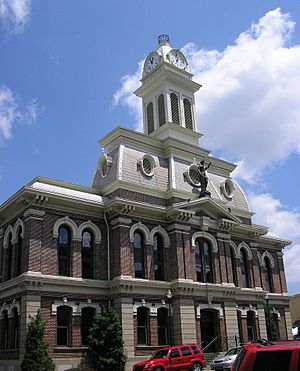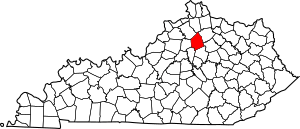Scott County, Kentucky facts for kids
Quick facts for kids
Scott County
|
|
|---|---|

Scott County courthouse in Georgetown
|
|

Location within the U.S. state of Kentucky
|
|
 Kentucky's location within the U.S. |
|
| Country | |
| State | |
| Founded | 1792 |
| Named for | General Charles Scott |
| Seat | Georgetown |
| Largest city | Georgetown |
| Area | |
| • Total | 285 sq mi (740 km2) |
| • Land | 282 sq mi (730 km2) |
| • Water | 3.7 sq mi (10 km2) 1.3% |
| Population
(2020)
|
|
| • Total | 57,155 |
| • Estimate
(2023)
|
60,168 |
| • Density | 200.5/sq mi (77.43/km2) |
| Time zone | UTC−5 (Eastern) |
| • Summer (DST) | UTC−4 (EDT) |
| Congressional district | 6th |
Scott County is a county located in the central part of Kentucky, a state in the United States. In 2020, about 57,155 people lived here. Scott County is part of the larger Lexington-Fayette area. The main city and county seat is Georgetown.
Contents
History of Scott County
People have lived in the Scott County area for a very long time, possibly as far back as 15,000 years ago! We know this from evidence left by ancient groups like the Adena culture, who lived here from about 800 B.C. to 800 A.D. They built several important mounds in the area.
Early Explorers and Settlers
American explorers first came to this area around 1774. One of the first settlers was John McClelland from Pennsylvania. He built a fort called McLelland's Fort near the Georgetown spring. During the American Revolution, Native Americans who supported the British attacked the fort in 1777. This caused the settlers to leave.
Six years later, a new settlement was started by Robert and Jemima Johnson. They built Johnson Station, which was later called Great Crossing. This was near the Elkhorn Creek, about five miles west of where Georgetown is today.
How Scott County Was Formed
Kentucky was originally part of Virginia. In 1776, Virginia created "Kentucky County." This large county was later divided into three smaller ones in 1780: Lincoln, Jefferson, and Fayette. In 1788, Woodford County was created from part of Fayette County.
On June 1, 1792, Kentucky officially became a state. One of the first things the new state government did was divide Woodford County into two parts. One of these parts became Scott County. It was named after General Charles Scott, a hero from the Revolutionary War. He later became Kentucky's fourth governor. Other counties created around the same time in 1792 included Clark, Shelby, Logan, and Green counties.
Georgetown's Beginnings
In 1784, a preacher named Elijah Craig helped create the town of Lebanon near McLelland's Fort. In 1790, the town's name was changed to George Town to honor President George Washington.
Elijah Craig is also known for starting many important things in the county. He founded the first classical school, the first sawmill, the first gristmill (for grinding grain), and even the first paper mill. He might have also made the area's first bourbon whiskey!
His academy, which taught subjects like Latin and Greek, later became part of Rittenhouse Academy. This academy then joined with Georgetown College in 1829.
Challenges and New Schools
After Elijah Craig passed away in 1808, the community faced some difficulties. When Barton Warren Stone, a leader in the Christian Churches movement, moved to Georgetown in 1816, he found the community struggling.
In 1825, the Choctaw Nation opened the Choctaw Academy in Scott County. This school was for Choctaw boys. It operated until 1842. The staff and records then moved with the Choctaw Nation to Indian Territory (now Oklahoma), where the Choctaw people had been relocated. Later, new schools like Spencer Academy and Armstrong Academy were opened for Choctaw children.
Scott County During the Civil War
During the American Civil War, Scott County had people fighting on both sides. About 118 soldiers from Scott County joined the Union Army, while around 1,000 joined the Confederate Army. In 1861, George W. Johnson, who was from Scott County, was chosen as the temporary Confederate governor of Kentucky.
Geography
Scott County covers about 285 square miles. Most of this area, about 282 square miles, is land. The remaining 3.7 square miles (about 1.3%) is water.
Neighboring Counties
Scott County shares borders with several other counties:
- Grant County (to the north)
- Harrison County (to the northeast)
- Bourbon County (to the east)
- Fayette County (to the southeast)
- Woodford County (to the southwest)
- Franklin County (to the west)
- Owen County (to the northwest)
Population Information
The population of Scott County has grown a lot over the years. In 1800, there were about 8,000 people. By 2020, the population had grown to over 57,000 people.
Diversity in Scott County
In 2000, most people in Scott County (about 91.94%) were White. About 5.35% were Black or African American. There were also smaller percentages of Native American, Asian, and other racial groups. About 1.61% of the population was Hispanic or Latino.
Age and Households
In 2000, about 26.30% of the people in Scott County were under 18 years old. About 11.80% were between 18 and 24. The largest group, 32.60%, was between 25 and 44 years old. The median age in the county was 32 years. This means half the people were younger than 32 and half were older.
There were 12,110 households in the county. About 38.50% of these households had children under 18 living with them. Most households (58.80%) were married couples living together.
Communities
Scott County has several towns and communities.
Cities
- Georgetown (This is the county seat, meaning it's where the county government is located.)
- Sadieville
- Stamping Ground
Unincorporated Communities
- Great Crossing (These are communities that are not officially part of a city.)
Notable People from Scott County
Many interesting people have come from Scott County:
- James C. C. Black – A U.S. Representative from Georgia.
- J. Campbell Cantrill – A politician and U.S. Representative from Kentucky.
- Julia Chinn – The common-law wife of Vice President Richard M. Johnson.
- Daniel Cook – The first Attorney General of Illinois.
- Basil Duke – A Confederate General during the Civil War.
- William H. Hatch – A politician and U.S. Representative from Missouri.
- Henry P. Haun – A politician and U.S. Senator from California.
- George W. Johnson – The first Confederate Governor of Kentucky.
- John T. Johnson – A politician and U.S. Representative from Kentucky.
- Richard M. Johnson – A politician who served as Vice President of the United States from 1837 to 1843.
- Tom L. Johnson – A U.S. Representative from Ohio and Mayor of Cleveland.
- John M. Palmer – A Civil War general and Governor of Illinois.
- James F. Robinson – The 22nd Governor of Kentucky.
- John M. Robinson – A United States Senator from Illinois.
- Robert Ward Johnson – A U.S. and Confederate senator from Arkansas.
- Ryan Quarles – Kentucky Commissioner of Agriculture.
- Gustavus W. Smith – A General in the Confederate Army.
- Junius Ward – A 19th-century horseman and plantation owner.
- Edith Summers Kelley – A Canadian author who wrote the novel Weeds.
See also
In Spanish: Condado de Scott (Kentucky) para niños

